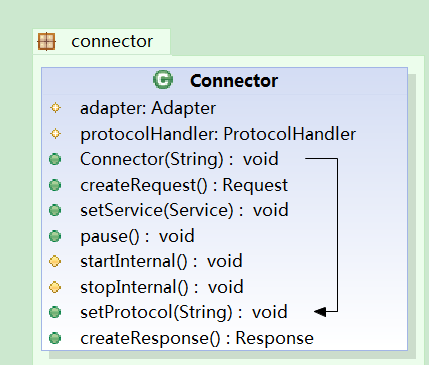
这个类图是本人截取的最重要的类的方法和属性。
其中ProtocalHandler是协议处理器,tomcat支持的协议以下方法可以看到。不同协议实现了不同的ProtocalHandler类。
public void setProtocol(String protocol) {
if (AprLifecycleListener.isAprAvailable()) {
if ("HTTP/1.1".equals(protocol)) {
setProtocolHandlerClassName
("org.apache.coyote.http11.Http11AprProtocol");
} else if ("AJP/1.3".equals(protocol)) {
setProtocolHandlerClassName
("org.apache.coyote.ajp.AjpAprProtocol");
} else if (protocol != null) {
setProtocolHandlerClassName(protocol);
} else {
setProtocolHandlerClassName
("org.apache.coyote.http11.Http11AprProtocol");
}
} else {
if ("HTTP/1.1".equals(protocol)) {
setProtocolHandlerClassName
("org.apache.coyote.http11.Http11NioProtocol");
} else if ("AJP/1.3".equals(protocol)) {
setProtocolHandlerClassName
("org.apache.coyote.ajp.AjpNioProtocol");
} else if (protocol != null) {
setProtocolHandlerClassName(protocol);
}
}
}ProtocalHandler是整个Connector类的核心。
初始化Connector的时候;根据协议名字创建处理器对象。
public Connector(String protocol) {
setProtocol(protocol);
// Instantiate protocol handler
ProtocolHandler p = null;
try {
Class<?> clazz = Class.forName(protocolHandlerClassName);
p = (ProtocolHandler) clazz.newInstance();
} catch (Exception e) {
log.error(sm.getString(
"coyoteConnector.protocolHandlerInstantiationFailed"), e);
} finally {
this.protocolHandler = p;
}
if (!Globals.STRICT_SERVLET_COMPLIANCE) {
URIEncoding = "UTF-8";
URIEncodingLower = URIEncoding.toLowerCase(Locale.ENGLISH);
}
}首先是初始化协议处理器(去除了不太重要的代码)
protected void initInternal() throws LifecycleException {
super.initInternal();
// 初始化Adapter
adapter = new CoyoteAdapter(this);
protocolHandler.setAdapter(adapter);
// 每个协议处理器都有对应的适配器,适配器干啥的呢?
protocolHandler.init();
}Connector的启动,实则是启动对应的协议处理器的启动,
protected void startInternal() throws LifecycleException {
// Validate settings before starting
if (getPort() < 0) {
throw new LifecycleException(sm.getString(
"coyoteConnector.invalidPort", Integer.valueOf(getPort())));
}
setState(LifecycleState.STARTING);
try {
protocolHandler.start();
} catch (Exception e) {
String errPrefix = "";
if(this.service != null) {
errPrefix += "service.getName(): \"" + this.service.getName() + "\"; ";
}
throw new LifecycleException
(errPrefix + " " + sm.getString
("coyoteConnector.protocolHandlerStartFailed"), e);
}
}终止实则是终止协议处理器
protected void startInternal() throws LifecycleException {
// Validate settings before starting
if (getPort() < 0) {
throw new LifecycleException(sm.getString(
"coyoteConnector.invalidPort", Integer.valueOf(getPort())));
}
setState(LifecycleState.STARTING);
try {
protocolHandler.start();
} catch (Exception e) {
String errPrefix = "";
if(this.service != null) {
errPrefix += "service.getName(): \"" + this.service.getName() + "\"; ";
}
throw new LifecycleException
(errPrefix + " " + sm.getString
("coyoteConnector.protocolHandlerStartFailed"), e);
}
}各位看管看到这里,其实看到连接器类需要做如下工作
(1)创建请求对象
/**
* Create (or allocate) and return a Request object suitable for
* specifying the contents of a Request to the responsible Container.
*/
public Request createRequest() { Request request = new Request();
request.setConnector(this);
return (request); }
(2)创建响应对象
/**
* Create (or allocate) and return a Response object suitable for
* receiving the contents of a Response from the responsible Container.
*/
public Response createResponse() { Response response = new Response();
response.setConnector(this);
return (response); }
(3)传给这两个对象给容器,简单而言,就是在创建好对象后,传递给那个适配器类就OK了。CoyoteAdapter类